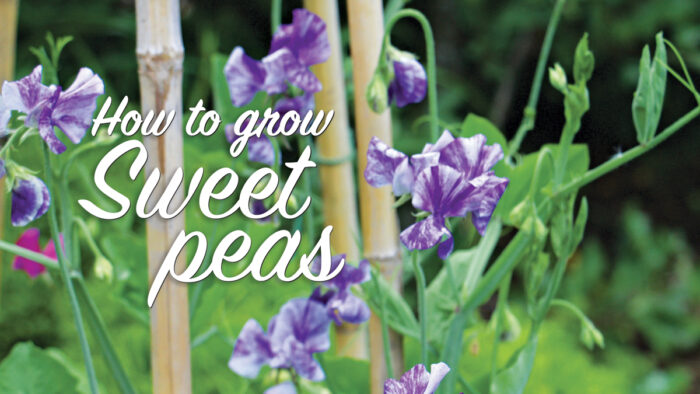
Fragrant, old-fashioned sweet peas were very popular cut flowers in the late nineteenth and early twentieth centuries, but then they fell out of favor for nearly a hundred years. With the recent emergence of the cut-flower farm movement, sweet peas have made a huge comeback, with many exciting and improved varieties available. Seeds are selling out everywhere.
To be truthful, sweet peas were never easy to fit into modern gardening designs. They rarely grow well in containers and are best grown as a seasonal crop in an area with lots of space. And yet it’s easy to appreciate them. They check off a lot of boxes with their unique fragrance and their delicate forms. Their real superpower, however, may be the diverse color possibilities of their blooms. Blooming sweet peas can resemble a bag full of Valentine’s Day candy, with nearly every imaginable shade of pink, red, white, and purple represented. This diversity makes choosing just a few varieties challenging. While sweet peas may require the sort of effort some people dread, it is often precisely the type of fussy work that appeals to practiced gardeners.
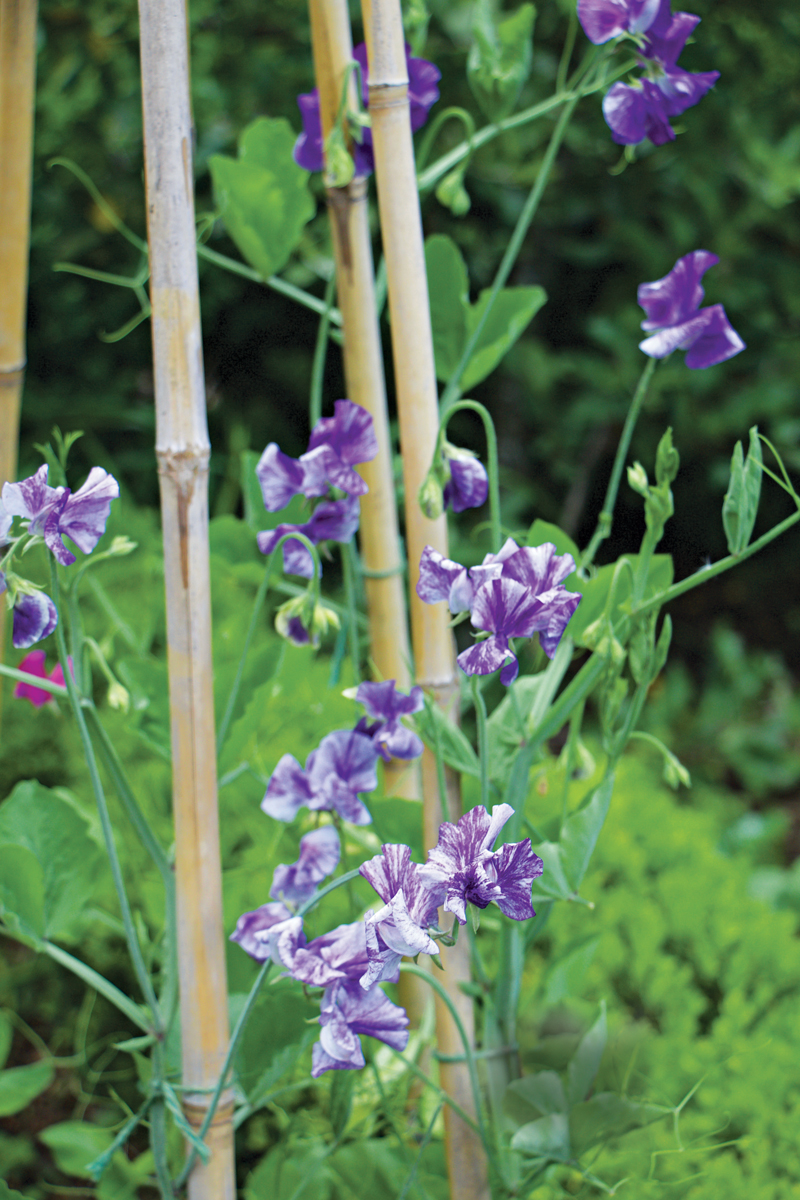
Starting seeds is simple
Although sweet pea seedlings are not often found at garden centers, they can be started easily from seed at home, and they benefit from an early start indoors. In colder climates, seeds should be started in late January through February. In warmer climates, you can start them in autumn. Some sources recommend that you soak seeds or chip them to soften the hard seed coats, but in reality these methods speed up germination by just a few days. Seed-starting pots should be deep, as sweet pea roots are long and grow straight down. Experienced growers use plug trays that are at least 5 inches deep; these are available from greenhouse supply companies. When planting, use a sterile potting mix that drains well. You will see well-intentioned hacks on social media recommending repurposing toilet paper tubes for starting sweet pea seeds, but the cardboard is likely to disintegrate long before your seedlings are ready to plant outdoors.
At a glance
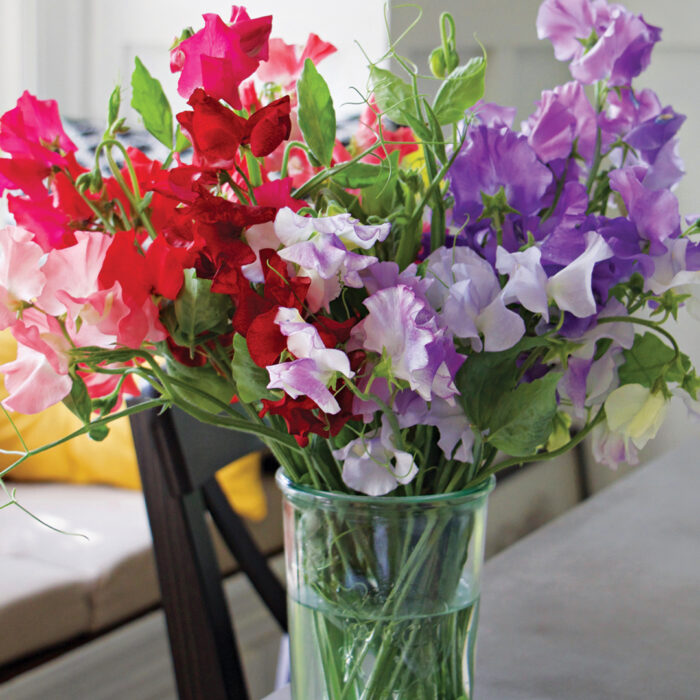
Name: Lathyrus odoratus
Zones: Annual
Size: 2 to 8 feet tall, depending on variety; 1 to 2 feet wide
Conditions: Full sun to partial shade; rich, well-drained soil
Native range: Crete, Italy, Sicily
Pests: Aphids may appear on growing tips, but they can be controlled easily with a mild organic spray. They may also disappear by themselves.
Diseases: The most common sweet pea ailment is powdery mildew, but that usually occurs later in the summer when blooms are already fading.
While I recommend sowing one seed per plug tray cell and giving sweet peas their own dedicated space in the garden, if you want to grow them in a border, then you can plant more seeds per container. Plant five to seven seeds in a 4- or 5-inch pot, and when it comes time to transplant, plant the entire root ball without disturbing any roots. Sweet pea plants that have been started indoors should be hardened off outdoors on mild days in early spring to acclimate them to cooler nights. Seeds can also be sown directly outside around the same time one would sow edible peas. This might be March for colder areas or late autumn or early winter in warmer climates. Sweet peas are very cold tolerant while young.

When seedlings are about 3 inches tall, the main growing tip must be pinched out, ideally just above the first two pairs of leaves (photo this page, bottom). Unpinched plants rarely perform as well as those that have been pinched. The goal here is to produce a stronger growing stem. For whatever reason, selecting a new side shoot to become the primary stem prompts the growth of large stems and blooms. You should only have to pinch out the main growing point once. Then you need to decide how many stems you will allow to grow. Purists hoping for the longest flower stems keep their plants growing on one stem, but most cut-flower farmers allow three to six stems to develop instead of one. This is a practical compromise that produces plants with slightly shorter stems but more blooms per plant. If you’re growing sweet peas in a border on branches, you may want to allow many branches to form for masses of small flowers, but you should still perform the initial pinch.
Give them some sun and daily attention
Choose a spot to plant your sweet peas that has rich, well-draining, neutral-pH soil. Amend with compost or manure, as sweet peas are heavy feeders. A sunny spot is best, with plants exposed to at least six hours of direct sun a day. Late afternoon shade is usually appreciated in hotter climates.
Be sure to cut flowers or deadhead blooms often to keep your plants flowering longer. The goal is to stop seedpods from forming, which will put an end to flowering. Sweet peas also demand lots of water, and if there is one trick to keeping vines blooming through hot summer weather, it is to water daily during those heat spells (although that may not stop your plants from suffering in heavy droughts or extreme heat).
Occasionally, buds may yellow and drop. This often happens in late spring due to temperature extremes, especially when chilly nights are paired with hot days. Bud drop naturally stops once the day and night temperatures become more stable. Bud drop can also occur if daytime temperatures become too hot (usually above 95°F), but again plants will adjust their bud production once the weather becomes reasonable again. If the weather is too hot, water early in the morning at soil level. Sweet peas prefer a cooler atmosphere where temperatures stay between 65°F and 80°F.
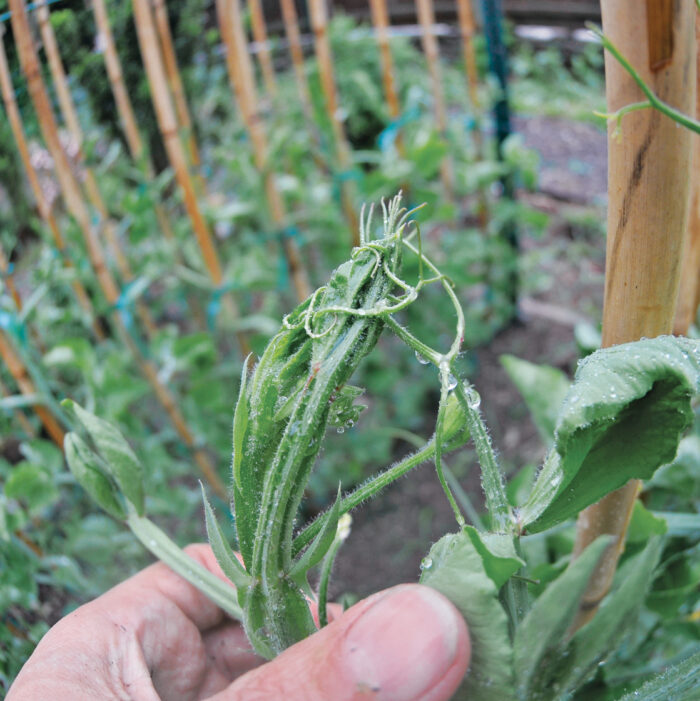
| Tip |
Remove some tendrils
While sweet peas are vines, the plants themselves do not twist or twine around a structure like morning glories (Ipomoea purpurea, annual) do. Rather, like grape vines, sweet peas produce thin tendrils that must grab onto netting or branches in order to climb up a structure. Because the tendrils reach out and grasp, they can easily grab onto leaves of the plant or even flowers, crushing them under their grip. While some tendrils are needed for grasping onto a structure, many should be removed to prevent such problematic growth. This requires frequent monitoring and trimming.
Different training methods yield different results
Before you plant your sweet peas, you must decide how you are going to support and train them. Many gardeners assume that sweet peas will produce blooms throughout the entire plant, thus covering a tower with flowers. The reality is that sweet peas only bloom at the ends of their stems, often only at the top of a structure. People also underestimate how tall vines will grow. Most sweet peas won’t begin blooming until daylight hours are at their longest (around the summer solstice) and when plants are already 5 to 6 feet tall. By then, vines are usually near the top of any garden structure. A good target height for whatever structure you create is 8 feet, and no matter which method you choose, it will require some tying of stems to provide support. There are four main methods that people use to train sweet peas, and each will achieve a different effect.
The cordon method is a labor-intensive but traditional way of training. It requires plants to grow on a single stem. Individual plants are each tied to a single bamboo cane. The canes are set in rows 8 to 10 inches apart and rows 3 to 4 feet apart. Ongoing care requires continually tying plants to the bamboo as they continue to grow. Restricting growth to one stem with no side shoots focuses all of the plants’ effort and energy into producing the absolute longest stems and largest flowers. The resulting plants will look like no other sweet peas produced through other methods. They will have gigantic leaves that can be four times larger than those of untrained plants. However, a plant with large leaves will also have monstrous tendrils (which are produced at the end of each leaflet). These tendrils must be snipped off as you tie the stems. While this requires a lot of work, the cordons will look attractive and will produce Instagram-worthy sweet peas.
Perhaps the easiest way to raise sweet peas as cut flowers is to grow them in a row with a tall sheet of netting between stakes. This is not as attractive as some other methods, but it is the best technique for growing cut flowers. Choose mesh with smaller openings, ideally black plastic mesh, but chicken wire works just fine. Using a larger grid mesh can be labor intensive and require more ties to keep stems from breaking during summer thundershowers, but it will work if you are growing your sweet peas in a greenhouse or polytunnel.
Sweet peas are naturally designed to grow over bushes in the wild. A dome constructed of twigs or a tower of pea brush (thin branches that have been cut and dried during the previous winter) will create a rounded structure for sweet peas to grow on. This method is the least labor intensive and is good for incorporating your sweet peas into beds and borders.
Although it’s a mistake to plant sweet peas on a trellis that is too thick or on a tuteur made of wood with nowhere for the thin tendrils to grasp, there is an easy solution. Wrap any of these structures with fine bird netting or plastic poultry mesh. While this may look untidy at first, sweet pea vines will quickly cover the structure, and you soon won’t even notice the netting.
However you decide to grow them, the classic beauty and fragrance of sweet peas makes all the effort worth it.
| Plants |
Varieties that won’t let you down
All sweet peas have beautiful blooms, but different varieties have been bred for different purposes. The following categories describe the various characteristics you can choose from when selecting the best sweet pea cultivars for your garden.
Spencers: Considered a revolution in plant breeding, the large Spencer types remain the gold standard for quality and vigor. Their pleated and ruffled flowers are unmatched, and they remain the go-to choice for those who exhibit sweet peas in competitions. Their long stems and large flowers make them great cut flowers, but this is often at the cost of fragrance. ‘Sir Jimmy Shand’ is a classic with lilac stripes. ‘Daily Mail’ has a very cool look with its ruffled salmon-pink petals.
Multifloras: Most multiflora varieties are old-fashioned plants that have many flowers and a great fragrance. But due to their short stems and small flowers, they don’t make the best cut flowers. Look for the nineteenth-century heirloom ‘Indigo King’, which has deep, vibrant colors. ‘Aphrodite’ is a modern multiflora from 2011 with seven or more white flowers per stem.

Early winter-flowering multifloras: These are day-neutral or short-day varieties (most sweet peas require gradually lengthening days to set flower buds). They have been bred for fall sowing in winter-mild climates like California. Varieties in the Sunshine series can bloom up to a month earlier than other sweet peas. ’Sunshine Light Blue’ has beautiful pastel colors.
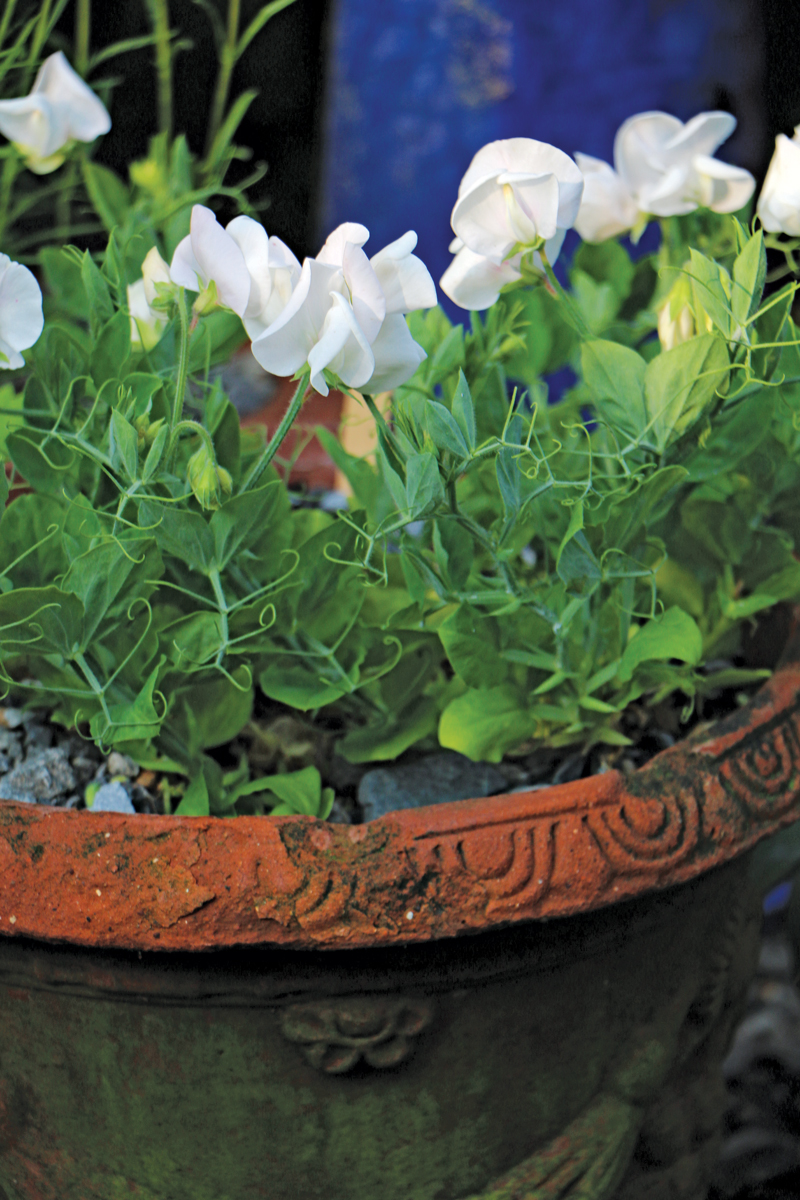
Dwarfs: Older strains from the mid-twentieth century are great for growing in containers or on a dome made of twigs. You can also look for improved strains such as ‘Jet Set’ and those from the Knee High series. If you want the shortest plants, go with the heirloom Cupid series.

Grandifloras: Modern grandifloras share some characteristics with multifloras but have significantly larger flowers and longer stems with more flowers. ‘Mautucana’ is a grandiflora with dark magenta and periwinkle petals. Semi-grandifloras were introduced within the past twenty years and have flowers even larger than those of modern grandifloras. They offer great fragrance and longer stems. Look for varieties such as the deeply indigo ‘Lord Nelson’ and the bicolored pink and purple ‘Erewhon’.
Sources
- Ardelia Farm, Irasburg, VT; ardeliafarm.com
- Floret Farm, Mount Vernon, WA; floretflowers.com
- Renee’s Garden, Felton, CA; 888-880-7228; reneesgarden.com
- Enchanting Sweet Peas, Sebastopol, CA; enchantingsweetpeas.com
- Select Seeds, Union, CT; 800-684-0395; selectseeds.com
Matt Mattus is the author of two books: Mastering the Art of Flower Gardening and Mastering the Art of Vegetable Gardening. He lives and gardens in Worcester, Massachusetts.
Fine Gardening Recommended Products

The New Organic Grower, 3rd Edition: A Master's Manual of Tools and Techniques for the Home and Market Gardener, 30th Anniversary Edition
Fine Gardening receives a commission for items purchased through links on this site, including Amazon Associates and other affiliate advertising programs.

The Nature of Oaks: The Rich Ecology of Our Most Essential Native Trees
Fine Gardening receives a commission for items purchased through links on this site, including Amazon Associates and other affiliate advertising programs.

Felco Pruning Shears (F 9) - High Performance Swiss Made One-Hand Left-Handed Garden Pruners
Fine Gardening receives a commission for items purchased through links on this site, including Amazon Associates and other affiliate advertising programs.





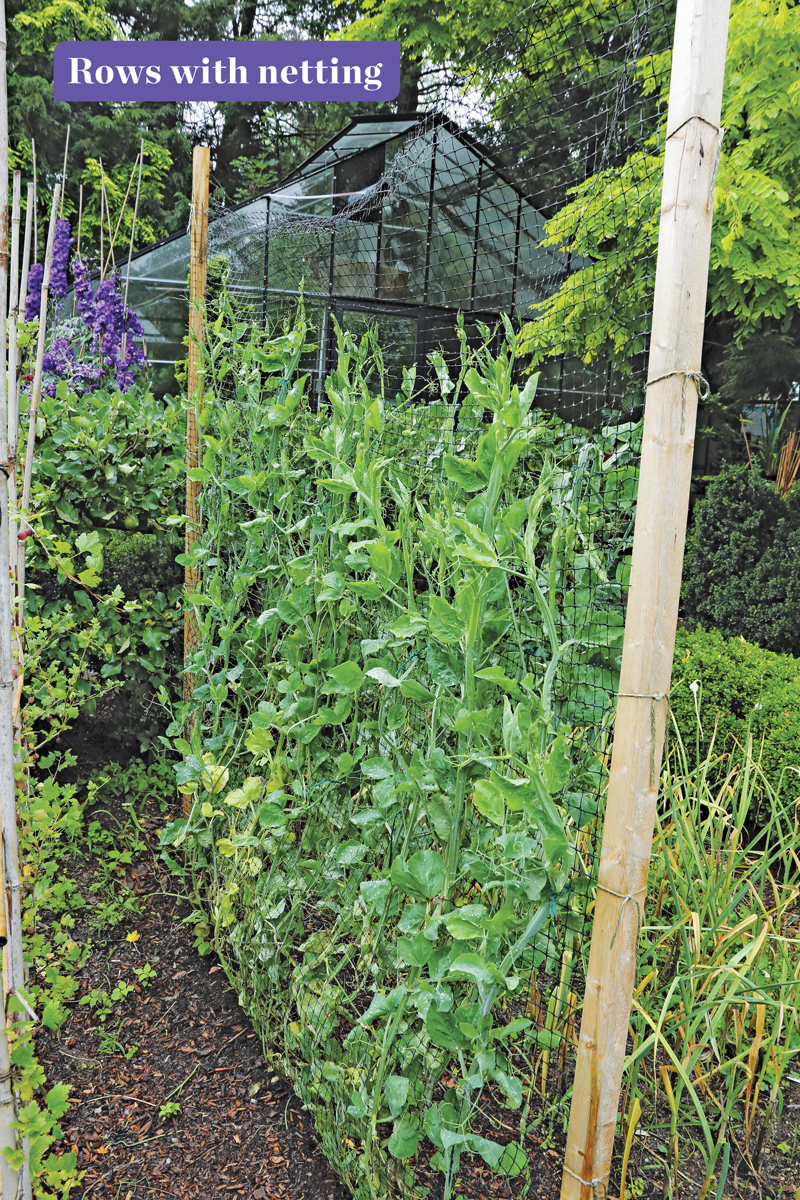























Comments
Log in or create an account to post a comment.
Sign up Log in